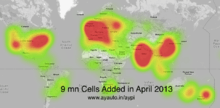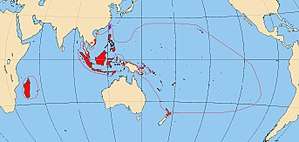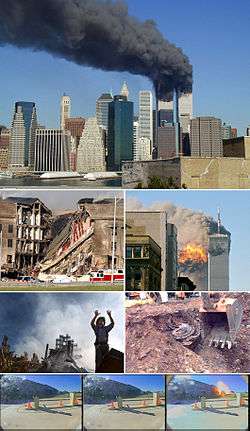Geography of media and communication
Geography of media and communication (also known as communication geography, media geography and geographies of media) is an interdisciplinary research area bringing together human geography with media studies and communication theory. Research addressing the geography of media and communication seeks to understand how acts of communication and the systems they depend on both shape and are shaped by geographical patterns and processes.
_(14755773482).jpg)

Overview
Geography of media and communication is an area of research, which considers various facets of communication. One interest is the layout and organization of communication systems at scales from cities to the planet. Closely related to this are the varying levels of access to communication systems from place to place. Attention to how places differ in regard to communication access leads to an interest in the changes that occur in places when new media diffuse into those places. A complementary interest is in how places are represented in various media—for example pictures of idyllic beaches in tourism advertisements or written descriptions of war zones in newspaper stories. Communications also allow people to interact with distant places, so a final area of investigation is how, by interacting with others through various kinds of communication systems, people inhabit various kinds of "virtual" spaces.[1][2]
Of particular interest to media/communication theorists are questions regarding the social and cultural formations associated with media, which in turn point to how media are involved in the transformation of belonging and citizenship, which relate to geographical territories. Social and cultural formations also depend on distinctions between public and private life, which have traditionally depended on spatial boundaries between public and private places.[3][4][5] Topics of particular interest to geographers are place representations in visual media including photography, film and graffiti, in auditory media including radio and music recordings, and even in embodied communications such as dance and video games.[6]
History

Geographical interest in the systematic study of communication can be traced to the writings of Richard Hartshorne in the 1930s.[7] Hartshorne considered language to be a key element forming culture regions, meaning that the dominant language is similar within a particular culture region and it changes when one leaves a culture region. A very different aspect of communication became the focus during the 1950s and 1960s as geographers began to measure and model the interactions between locations. In this case, geographers involved in the quantitative revolution explained the accelerating flow of information between locations in terms of "time-space convergence" and "human extensibility."[8][9] It was not until the 1970s that geographers began to focus on communications in terms of content, considering questions of symbolism, representation, metaphor, iconography and discourse. This interest first took form in geographical research that drew on humanism, phenomenology and hermeneutics.[10] By the 1990s, this approach shifted towards a more critical sensibility unpacking the various meanings of landscape.[11][12][13] Geographers researching communication over the past two decades have extended these research areas while carrying forward early insights regarding the importance of communication to the formation of regions, the rate of information flow as a measure of spatial interaction, and the association between landscape and representation. New approaches to communication have been advanced under the frameworks of non-representational theory, actor-network theory, and assemblage theory.[14][15] Equally important is the effort to think through digital code and its relationship with space.[16]
Areas of study

According to one taxonomy, the geography of media and communication involves four complementary aspects: places-in-media, media-in-places, media-in-spaces and spaces-in-media.[17][18] Places-in-media are representations of place circulating in all sorts of media for all sorts of reasons, for example landscape paintings signifying the owner's status, and news images of urban spaces linking crime and chaos to minority populations and the poor.[19] Media-in-places are ways in which particular places such as the home, classroom, workplace, or city street are altered functionally and experientially by transformations in how people use media in those places.[20] Media-in-spaces are communication infrastructures, whether historical, like telegraph cables, or contemporary like optical fiber cable when mapped and analyzed in terms of their physical layout. Spaces-in-media are the topologies that symbols, images, information and ideas move through as they spread or diffuse from person to person and from group to group.
Notable scholars
Geographers interested in media and communication
- Ronald F. Abler
- John A. Agnew
- Paul C. Adams
- Trevor J. Barnes
- Jacquelin Burgess
- Denis Cosgrove
- Tim Cresswell
- Julie Cupples
- Simon Dalby
- Jason Dittmer
- Klaus Dodds
- Peter Gould
- Mark Graham
- Derek Gregory
- David Harvey
- Eric Laurier
- Chris Lukinbeal
- Doreen Massey
- John Pickles
- Gillian Rose (Geographer)
- Nigel Thrift
- Yi-Fu Tuan
- Gearóid Ó Tuathail / Gerard Toal
- Gill Valentine
- Torsten Wissmann
- Stefan Zimmermann
Media/communication scholars interested in geography
See also
External links
Notes
- Adams, Paul C.; Jansson, André (2012). "Communication Geography: A Bridge between Disciplines". Communication Theory. 22. pp. 299-317.
- Crang, Mike; Crang, Phil; May, Jon (1999). Virtual Geographies: Bodies, Space and Relations. London: Routledge.
- Couldry, Nick (2012). Media, society, world: Social theory and digital media practice. Polity.
- Georgiou, Myria (2013). Media and the city: Cosmopolitanism and Difference. Polity.
- Sheller, Mimi; Urry, John (2003). "Mobile transformations of 'public' and 'private' life". Theory, Culture & Society (3). p. 107-125.
- Adams, Paul C.; Craine, Jim; Dittmer, Jason (2014). The Ashgate Research Companion to Media Geography. Burlington, VT Press: Ashgate. ISBN 978-1409444015.
- Hartshorne, Richard (1939). The nature of geography: A critical survey of current thought in the light of the past. Annals of the Association of American Geographers.
- Janelle, Donald G. (1968). "Central Place Development in a Time‐Space Framework". Professional Geographer. 20. pp. 5–10.
- Janelle, Donald G. (1973). "Measuring human extensibility in a shrinking world". Journal of Geography. 72 (2). pp. 8–15.
- Tuan, Yi-Fu (1977). Space and Place: The Perspective of Experience. Minneapolis: University of Minnesota Press.
- Burgess, Jacquelin; Gold, John R. (1985). Geography, the Media and Popular Culture. Croom Helm.
- Duncan, James S.; Ley, David (1993). Place/Culture/Representation. London: Routledge.
- Barnes, Trevor J.; Duncan, James S. (2013). Writing Worlds: Discourse, Text and Metaphor in the Representation of Landscape. London: Routledge.
- Thrift, Nigel (2008). Non-representational Theory: Space, Politics, Affect. London and New York: Routledge.
- Murdoch, Jonathan (1998). "The spaces of actor-network theory". Geoforum. 29 (4). pp. 357–374.
- Kitchin, Rob; Dodge, Martin (2011). Code/Space: Software and Everyday Life. Cambridge, Massachusetts: MIT Press.
- Adams, Paul C.; Jansson, André (2012). "Communication Geography: A Bridge between Disciplines". Communication Theory. 22. pp. 299-317.
- Adams, Paul C. (2011). "A taxonomy for communication geography". Progress in Human Geography. 35 (1). pp. 37–57.
- Burgess, Jacquelin; Gold, John R. (1985). Geography, the Media and Popular Culture. Croom Helm.
- Morley, David (2005). Family Television: Cultural Power and Domestic Leisure. London: Routledge.
